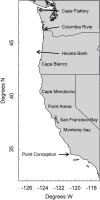Spatio-temporal patterns in juvenile habitat for 13 groundfishes in the California Current Ecosystem
- PMID: 32822408
- PMCID: PMC7442253
- DOI: 10.1371/journal.pone.0237996
Spatio-temporal patterns in juvenile habitat for 13 groundfishes in the California Current Ecosystem
Abstract
Identifying juvenile habitats is critical for understanding a species' ecology and for focusing spatial fishery management by defining references like essential fish habitat (EFH). Here, we used vector autoregressive spatio-temporal models (VAST) to delineate spatial and temporal patterns in juvenile density for 13 commercially important species of groundfishes off the US west coast. In particular, we identified hotspots with high juvenile density. Three qualitative patterns of distribution and abundance emerged. First, Dover sole Microstomus pacificus, Pacific grenadier Coryphaenoides acrolepis, shortspine thornyhead Sebastolobus alascanus, and splitnose rockfish Sebastes diploproa had distinct, spatially-limited hotspots that were spatially consistent through time. Next, Pacific hake Merluccius productus and darkblotched rockfish Sebastes crameri had distinct, spatially limited hotspots, but the location of these hotspots varied through time. Finally, arrowtooth flounder Atheresthes stomias, English sole Parophrys vetulus, sablefish Anoplopoma fimbria, Pacific grenadier Coryphaenoides acrolepis, lingcod Ophiodon elongatus, longspine thornyhead Sebastolobus altivelis, petrale sole Eopsetta jordani, and Pacific sanddab Citharichthys sordidus had large hotspots that spanned a broad latitudinal range. These habitats represent potential, if not likely, nursery areas, the location of which will inform spatial management.
Conflict of interest statement
The authors have declared that no competing interests exist.
Figures







Similar articles
-
Hemoflagellates of Oregon marine fishes with the description of new species of Trypanosoma and Trypanoplasma.J Parasitol. 2007 Dec;93(6):1442-51. doi: 10.1645/GE-1220.1. J Parasitol. 2007. PMID: 18314692
-
The role of carrion supply in the abundance of deep-water fish off California.PLoS One. 2012;7(11):e49332. doi: 10.1371/journal.pone.0049332. Epub 2012 Nov 2. PLoS One. 2012. PMID: 23133679 Free PMC article.
-
Interannual distribution of Pacific hake Merluccius productus larvae in the southern part of the California Current.J Fish Biol. 2009 Aug;75(3):630-46. doi: 10.1111/j.1095-8649.2009.02327.x. J Fish Biol. 2009. PMID: 20738561
-
Climate mediates hypoxic stress on fish diversity and nursery function at the land-sea interface.Proc Natl Acad Sci U S A. 2015 Jun 30;112(26):8025-30. doi: 10.1073/pnas.1505815112. Epub 2015 Jun 8. Proc Natl Acad Sci U S A. 2015. PMID: 26056293 Free PMC article.
-
The functional value of Caribbean coral reef, seagrass and mangrove habitats to ecosystem processes.Adv Mar Biol. 2006;50:57-189. doi: 10.1016/S0065-2881(05)50002-6. Adv Mar Biol. 2006. PMID: 16782451 Review.
References
-
- Elton CS. Animal Ecology. London: Sidgwick & Jackson, Ltd; 1927.
-
- Thorson JT, Shelton AO, Ward EJ, Skaug HJ. Geostatistical delta-generalized linear mixed models improve precision for estimated abundance indices for West Coast groundfishes. ICES J Mar Sci. 2015; 72(5): 1297–1310. 10.1093/icesjms/fsu243 - DOI
-
- Johnson CJ, Seip DR, Boyce MS. A quantitative approach to conservation planning: using resource selection functions to map the distribution of mountain caribou at multiple spatial scales. J Appl Ecol. 2004; 41(2): 238–251. 10.1111/j.0021-8901.2004.00899.x - DOI
-
- PFMC. Pacific coast groundfish 5-year review of essential fish habitat. Report to Pacific Fishery Management Council. Phase 1: New information, September 2012. Pacific Fishery Management Council, Portland, OR. 2012.
-
- NMFS. Pacific Coast Groundfish Fishery Management Plan; Essential Fish Habitat Designation and Minimization of Adverse Impacts; Final Environmental Impact Statement. NOAA National Marine Fisheries Service, Northwest Region, 7600 Sand Point Way NE, Seattle, WA. 2005.
MeSH terms
LinkOut - more resources
Full Text Sources

